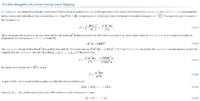Hi all,
I am studying linear algebra recently and following immersive math book. Now I am reading the section about how to determine input v gives the largest and smallest elonggation through linear mapping F(v)=Av. Here is the explanation and deduction:


However, I cannot understand these explanantions marked with red box above. How could he deduce 'null space of at least dimension 1' from previous conditions? Can somebody help me explain more about this? Thanks.
I am studying linear algebra recently and following immersive math book. Now I am reading the section about how to determine input v gives the largest and smallest elonggation through linear mapping F(v)=Av. Here is the explanation and deduction:


However, I cannot understand these explanantions marked with red box above. How could he deduce 'null space of at least dimension 1' from previous conditions? Can somebody help me explain more about this? Thanks.
